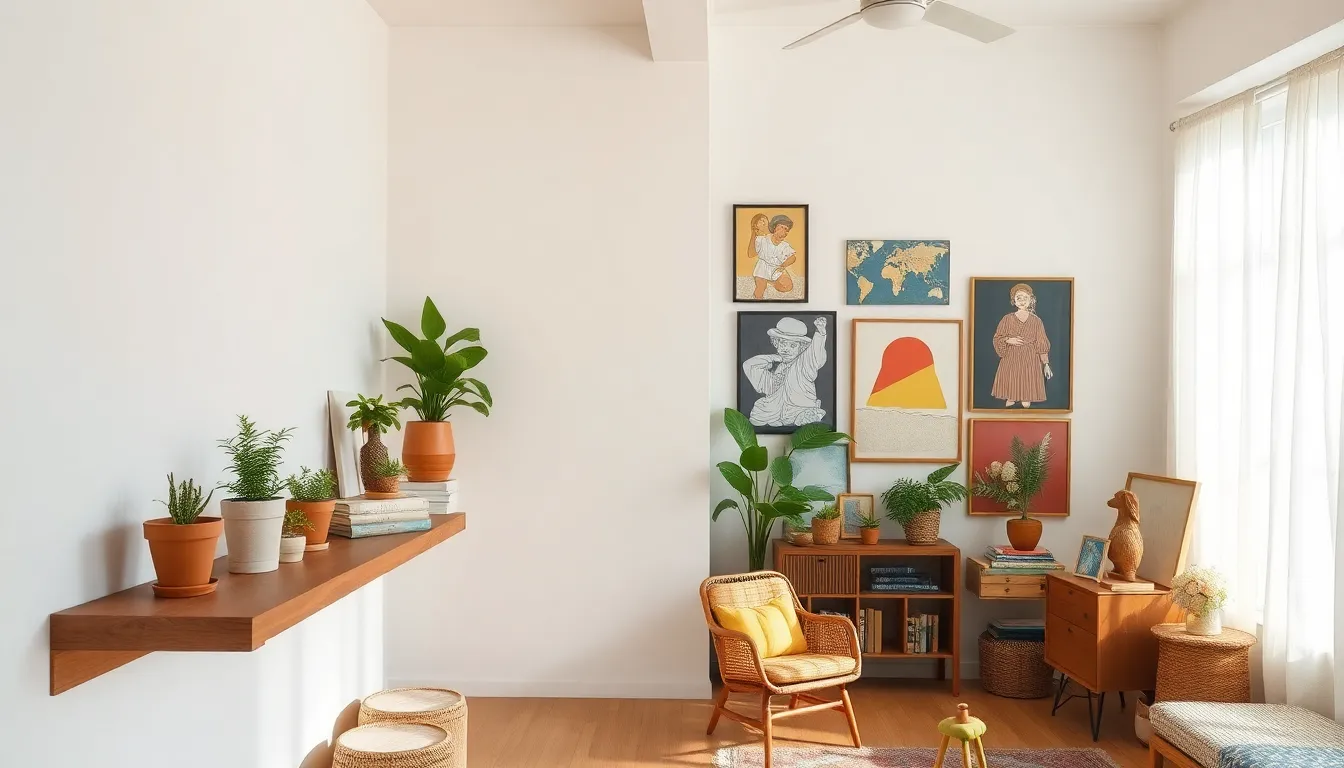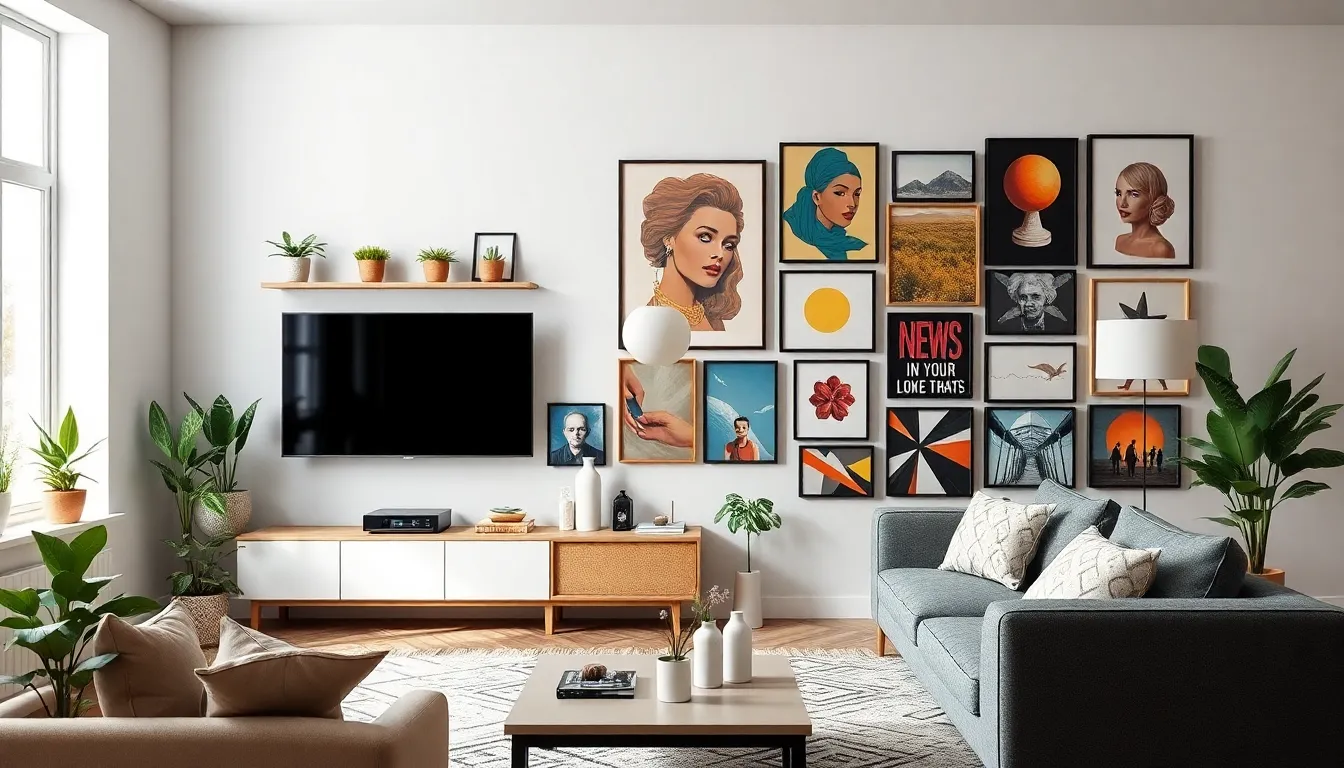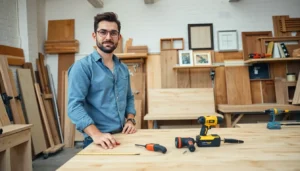In a world where individuality reigns, modern DIY decor offers a creative outlet for those looking to personalize their spaces. Gone are the days of cookie-cutter designs; today, homeowners embrace unique touches that reflect their style and personality. With a few simple tools and materials, anyone can transform their living environment into a stunning showcase of creativity.
From upcycled furniture to handcrafted wall art, modern DIY projects blend sustainability with aesthetic appeal. This trend not only enhances the home but also fosters a sense of accomplishment and pride. As people seek to create cozy and inviting atmospheres, the possibilities for DIY decor are endless, making it an exciting journey for both seasoned crafters and beginners alike.
Table of Contents
ToggleOverview of Modern DIY Decor
Modern DIY decor represents a transformative approach to home aesthetics, emphasizing creativity and individuality. This trend encourages individuals to personalize living spaces, moving away from mass-produced items toward unique creations.
Key elements of modern DIY decor include:
- Upcycled Materials: Utilizing materials from old furniture or discarded items reduces waste and contributes to sustainable practices while adding character.
- Handcrafted Elements: Craftspeople design everything from wall art to furniture, focusing on quality and uniqueness rather than conformity.
- Personalized Designs: Individuals infuse personal style into projects, resulting in decor that reflects their tastes and preferences.
Modern DIY decor also enables a rewarding experience. Individuals derive satisfaction from creating beautiful home environments and developing skills. This movement continues to gain traction, appealing to both seasoned crafters and those new to DIY projects.
Popular Styles in Modern DIY Decor


Modern DIY decor showcases various styles that adapt to individual tastes and preferences. Two prominent styles include minimalist aesthetics and eclectic combinations.
Minimalist Aesthetics
Minimalist aesthetics emphasize simplicity and functionality. Clean lines, neutral color palettes, and uncluttered spaces define this style. DIY projects may include creating simple wooden shelves, fabric wall art, or understated planters. Individuals focusing on minimalism often select high-quality materials that enhance the overall design without overwhelming it. Incorporating soft textures through textiles like linen and cotton fosters warmth while maintaining a tranquil atmosphere.
Eclectic Combinations
Eclectic combinations merge contrasting elements to create unique decor. This style allows for mixing various materials, colors, and patterns. DIY enthusiasts might repurpose vintage furniture alongside contemporary pieces or combine bold art prints with rustic accents. Creativity in blending different styles fosters personal expression and adds depth to space. Successful projects may involve paint techniques, layering accessories, or curated gallery walls that showcase diverse artistic influences. Embracing eclecticism invites innovation while making a bold statement in any room.
Essential Tools and Materials
Equipping oneself with the right tools and materials enhances the DIY decor experience, making projects efficient and enjoyable. Below are essential tools and recommended materials that elevate creative endeavors.
Must-Have Tools for DIY Projects
- Measuring Tape: Essential for accurate measurements, ensuring precise cuts and placements.
- Utility Knife: Useful for cutting various materials, from cardboard to fabric, for clean results.
- Drill: Necessary for making holes in walls or assembling pieces, offering versatility in projects.
- Screwdriver Set: Important for tightening screws and assembling furniture, with varied sizes to accommodate different needs.
- Paintbrushes and Rollers: Vital for painting surfaces evenly and achieving desired finishes in decor projects.
- Hot Glue Gun: Great for quick bonding of materials, supporting permanent and temporary fixtures with ease.
- Level: Crucial for ensuring artworks and shelves hang straight, promoting professional-looking displays.
Recommended Materials for Stylish Decor
- Plywood: Excellent for crafting furniture or wall decor; its versatility adapts to various aesthetics.
- Mason Jars: Perfect for storage and displaying flowers; adds a rustic charm to any space.
- Fabric Scraps: Useful for creating cushions or wall hangings; encourages creativity through unique patterns and textures.
- Paint: Offers endless color options for refreshing furniture or accent walls, supporting personal style.
- Nails and Screws: Necessary for sturdy construction, ensuring the longevity of projects.
- Wire: Ideal for creating wall art or hanging planters, enabling artistic expression.
- Natural Elements: Incorporating stones, driftwood, or plants enhances decor with organic touches, reinforcing sustainability.
These tools and materials empower DIY enthusiasts to explore their creativity, fostering personal expression in modern decor.
Step-by-Step Project Ideas
Modern DIY decor offers various projects that allow individuals to personalize their spaces creatively. Below are two distinctive types of projects that exemplify the essence of contemporary DIY decor.
Wall Art Creations
- Canvas Painting: Choose a blank canvas and select a color palette. Use acrylic paints for vibrant designs. Apply multiple layers for depth, incorporating techniques like sponging or splattering.
- Gallery Wall: Gather an assortment of picture frames in different sizes. Arrange the frames on the floor to experiment with layout before transferring it to the wall. Fill frames with personal photos, artwork, or prints to create a cohesive visual story.
- Macrame Wall Hanging: Cut cotton rope into lengths for various knots. Use a wooden dowel to tie the macrame pieces, alternating knot styles for texture. Hang the finished piece to add a tactile element to any wall.
- Wooden Signs: Use reclaimed wood for character. Sand the surface to smooth it out. Apply paint or wood stain, then use stencils or freehand techniques to create inspirational quotes or decorative designs.
Furniture Upcycling
- Chalk Paint Makeover: Select an old wooden chair or dresser. Clean and lightly sand the surface. Apply a coat of chalk paint for a matte finish, followed by a wax seal for durability. Add decorative hardware for a refreshed look.
- Repurposed Crates: Gather wooden crates and stack them to create a rustic bookshelf or side table. Paint or stain for an updated appearance. Use them individually or combined for unique storage solutions.
- Fabric Upholstery: Find an outdated upholstered chair. Remove the old fabric and cushioning. Choose a vibrant or patterned fabric that complements the room. Staple the new material tightly to the frame for a polished finish.
- Painted Nightstand: Take a plain nightstand and apply a bold color using spray paint or a paintbrush. Replace old knobs with modern hardware for a trendy twist. Consider adding a decoupage technique to the drawer for added flair.
These projects not only enhance living spaces but also contribute to a sustainable lifestyle by repurposing existing materials and showcasing personal creativity.
Tips for Success in DIY Decor
Successful DIY decor projects combine careful planning and resourceful sourcing. Certain strategies enhance the outcome of each project while remaining budget-friendly.
Planning and Design
Planning and design foster a clear vision for each project. Establishing a theme unifies decor elements, while sketching ideas provides insight into color combinations and layout. Selecting the right materials related to the desired aesthetic ensures consistency throughout the space. Allowing for flexibility during the process enables adjustments. Testing arrangements and visual balance contributes to an appealing final result.
Budgeting and Sourcing
Budgeting and sourcing significantly impact DIY projects. Setting a realistic budget allows for thoughtful material choices. Exploring local hardware stores, thrift shops, and online marketplaces offers affordable options while encouraging creativity. Using reclaimed or surplus materials reduces costs and enhances sustainability. Researching DIY tutorials guides sourcing decisions and enables crafters to compare prices. Prioritizing quality over quantity ensures long-lasting results and satisfaction.


